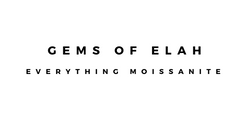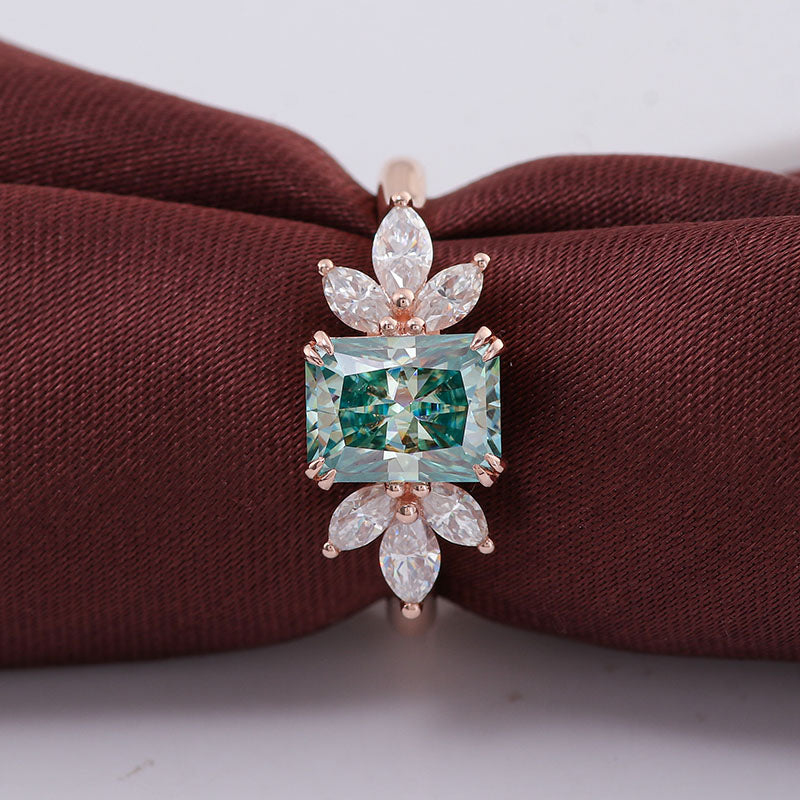1. What is moissanite?
Moissanite is a naturally occurring mineral made of silicon carbine that is found in limited quantities on earth. Moissanite was first discovered in 1893 by Henri Moissan in trace amounts carried to Earth by a meteorite – which is why it’s often referred to as a gemstone born from the stars.
2. Where does moissanite come from?
Natural moissanite is incredibly rare as it was found in a meteorite. Most moissanite available today is laboratory-created. produced through a process known as chemical vapour deposition (CVD) or high temperature-high pressure (HPHT) method. These methods are used to mimic the natural processes that form moissanite, but are done in a controlled laboratory environment.
3. What are the main differences between moissanite and a diamond?
Composition: Diamonds are made of carbon, while moissanite is made of silicon carbide.
Hardness: Diamonds are the hardest known natural mineral and have a hardness of 10 on the Mohs scale, while moissanite has a hardness of 9.25-9.5 on the Mohs scale.
Refractive index: The refractive index, or the ability of a material to bend light, is higher in moissanite than in diamond. This gives moissanite a more "brilliant" or "sparkly" appearance.
Dispersion: Dispersion, also called "fire," refers to the ability of a material to break light into its component colours. Moissanite has a higher dispersion than diamond, which means it can produce more "rainbow" colours when viewed from different angles.
4. OK, but which one is better?
Moissanite and diamond are two popular choices for gemstones, but they have some distinct differences that may make one more favourable than the other.
We will talk about the benefits of moissanite:
Affordability: Moissanite is a lot more affordable than diamond, making it an excellent option for getting more for your money.
Sparkle: Moissanite has a higher refractive index than diamond, which means it has 2.4 time more sparkle.
Eco-Friendly: Moissanite is a lab-created stone, which means it has less environmental impact than mined diamonds.
Variety: Moissanite comes in a variety of colours, while most diamonds are usually colourless or the ones with colour are ultra-pricey.
Clarity: Moissanite is usually flawless or near-flawless, while diamonds often have inclusions or blemishes. An IF (Internally Flawless) clarity moissanite in 2 carats is an achievable feat. The same in a diamond can cost over $100,000. Yes, that many zeros.
Ethical concerns: Moissanite is not associated with any negative ethical concerns like diamond, which is often associated with blood diamond trade.
All in all, Moissanite is a great alternative for diamond at a more favourable price point.
5. Is moissanite durable?
Yes, it's a forever gemstone.
Moissanite is one of the toughest known gemstones measuring 9.25 on the Mohs Scale of Hardness. Which makes it perfect for an engagement ring (or a piece of jewellery that can be worn every day).
A moissanite should last for your entire life without losing its appearance. If you choose a setting that’s made from a high-quality metal such as gold or silver, moissanite jewellery will last for a very long time.
6. How do you determine the quality of moissanite?
There are several factors to consider when determining the quality of a moissanite gemstone, including the 4 C’s:
Cut: The cut of a moissanite gemstone refers to its shape, symmetry, and proportions. A well-cut moissanite will have good symmetry, a balanced shape, and well-proportioned facets that will maximize the stone's sparkle and brilliance.
Colour: Moissanite is available in a variety of colours, including colourless, near-colourless, and yellow. A colourless moissanite is considered to be of higher quality than a yellow or near-colourless moissanite.
Clarity: Moissanite is typically flawless or near-flawless, with inclusions or blemishes that are not visible to the naked eye.
Carat weight: The carat weight of a moissanite gemstone refers to its size. Larger moissanite gemstones are more valuable than smaller ones.
Moissanite is a lab-created gemstone, so the quality of the gemstone can be controlled and is usually consistent.
7. How much does moissanite cost in comparison to diamonds?
Like diamonds, the cost of moissanite can vary depending on factors such as the 4 C’s: cut, clarity, colour and carat weight.
However, unlike diamonds which increases in price exponentially with larger carat size, moissanite prices increase gradually with size.
Here are a few examples of moissanite prices:
- A 1 carat colourless, round moissanite can cost around $300 to $600
- A 2 carat colourless, round moissanite can cost around $800 to $1,500
- A 3 carat colourless, round moissanite can cost around $1,500 to $3,000
These prices can vary depending on the specific characteristics of the moissanite and the market conditions. Also, it's important to consider that moissanite is lab-created, so the price will depend on the cost of production.
A diamond of the same size and quality can cost several times more than moissanite.
It’s important to note that the price of diamonds increases exponentially with larger carat size due to the diamond industry’s monopoly, in which a few companies set the prices, who have a long history of price inflation and artificially creating a high price for larger diamond.
Additionally, the diamond industry often uses clever marketing tactics to create the illusion of rarity and exclusivity, driving prices even higher. This makes it hard for consumers to determine the true value of a diamond and can lead to overpaying for diamond jewellery.
8. Will moissanite retain its value over time?
Moissanite is expected to retain its value over time. Moissanite is a lab-created gemstone and its value is based on the cost of production, market demand and the perceived value by the consumer.
However, moissanite is usually not purchased in terms of investment or financial gain due to it still being a new gemstone. Moissanite jewellery is purchased for its beauty, durability, unlimited design and style choice not limited by price and to avoid the artificially inflated prices of diamonds.
Additionally, the price of moissanite will not drop 70% as soon as you take it home. This is what happens with most diamonds on the market, only the diamonds with exceptional colour and clarity (i.e. the eye-wateringly expensive ones) retain their value.
9. Does moissanite lose its sparkle or get cloudy?
Moissanite will not lose its sparkle or get cloudy over time. The clarity and colour of the stone won’t change through the years. Moissanite is also resistant to scratches, heat, and chemicals, which makes it a durable option for everyday wear. However, like any other gemstone, it may become dirty over time and need to be cleaned to restore its sparkle.
Additionally, if the moissanite is not cut and polished properly, it may not have the same level of sparkle and brilliance as a well-cut and polished stone.
It is also important to note that if a moissanite is exposed to extremely high temperatures, it may develop a yellow or grey discoloration. But this is a rare case and can be restored by a professional jeweller.
Proper care and cleaning can help maintain the moissanite's shine and sparkle. Avoiding harsh chemicals and cleaning it with mild soap and water is recommended.
10. How can I make my moissanite ring look more like a diamond engagement ring?
The inevitable question. We love our moissanites and wear them loud and proud. But if you really want a diamond, here are some ways to make your moissanite look more like a diamond:
Choose the right cut. When it comes to making your moissanite look like a diamond, the right cut is key. The round brilliant cut is the shape that looks most like a diamond.
Choose the right metal. A moissanite set with gold or platinum will look more like a diamond, it’s rare for a diamond engagement ring to be set with silver.
The setting you choose can also make a huge difference in how your moissanite looks. Choose a setting with a lot of prongs or a halo setting to maximise the sparkle factor. Diamond rings are often set with halos to make the diamond look bigger.
Clean your moissanite regularly. Just like with a diamond, regular cleaning is essential to keep your moissanite looking its best sparkly self.
Have more questions about moissanite? Check out our other posts or get in touch.

